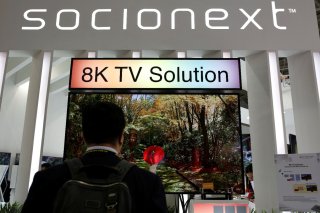Why Don't Consumers Love 8K TVs?
About 350,000 8K units were shipped in 2021, representing about 0.15 percent of the overall TV market.
Televisions in the 8K format have been around for a long time, nearly as long as 4K TVs. But the TVs have never quite caught on. This is mostly due to the fact that 8K TVs are generally more expensive than 4K models while there is very little 8K content available for buyers to watch.
There has been industry skepticism about the format for some time, with ABI Research projecting in late 2020 that only about 1 percent of worldwide flat panel TV shipments will be 8K TV sets in 2021.”
Now, a new analysis indicates once again that there’s not much consumer interest in the format. As reported by Digital TV Europe, Omdia’s senior director for media and entertainment, Maria Rua Aguete, appeared at the NAB show in Las Vegas this week and showed that 8K only represented a tiny sliver of the overall TV market last year.
Per the presentation, about 350,000 8K units were shipped in 2021, representing about 0.15 percent of the overall TV market. The presentation also said that while Samsung moved 65 percent of 8K units in 2021, it also shipped 18 percent fewer 8K TVs than it did the year before. Omdia predicted that 8.7 million households will have 8K TVs by the end of 2026, with just 701,000 of them in the United States.
Samsung did, however, include 8K models in its Neo QLED range when it rolled out its 2022 TV models. “Viewers can immerse themselves in the stunning detail of 8K without the need for native 8K content thanks to its Neural Quantum Processor 8K with AI,” the company said in its press release. “With Samsung’s growing 8K Ecosystem, users can simply pair Samsung’s new Galaxy S22 to playback the content captured in native 8K resolution on any Samsung Neo QLED 8K screen.”
“We see no evidence of mainstream 8K TV services, broadcasters are struggling with the business case for 4K,” Aguete said in the NAB presentation. “China will not drive 8K compared to North America or even Western Europe, despite the large set sizes as the price pressure is too high,” Aguete added. “We see no convincing market demand for further 8K service development. Even in Japan, where there is a true 8K channel (from NHK), uptake has been minimal.”
There has, however, been plenty of adoption of UHD, which mostly consists of 4K. “While China leads on UHD shipments, its huge number of households means that it takes longer to build a UHD installed base, achieving 50% in 2023,” Aguete said, per the report. “North America will lead, with half of households having a UHD set at the end of 2020, and 77% in 2025. Western Europe will reach 50% in 2024, with a faster growth rate than China due to a more rapid TV replacement rate.
Stephen Silver, a technology writer for The National Interest, is a journalist, essayist and film critic, who is also a contributor to The Philadelphia Inquirer, Philly Voice, Philadelphia Weekly, the Jewish Telegraphic Agency, Living Life Fearless, Backstage magazine, Broad Street Review and Splice Today. The co-founder of the Philadelphia Film Critics Circle, Stephen lives in suburban Philadelphia with his wife and two sons. Follow him on Twitter at @StephenSilver.
Image: Reuters

